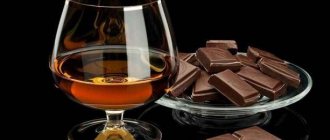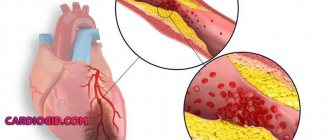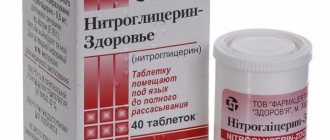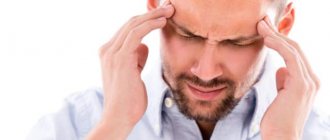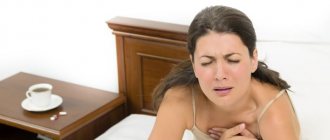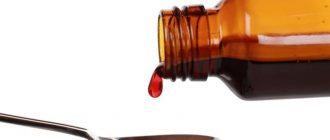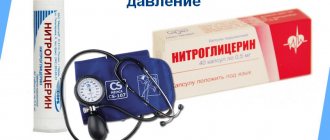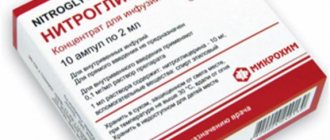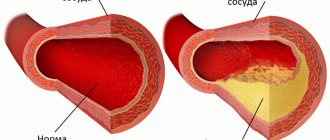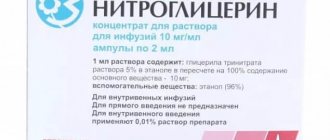Exercise therapy for hypertension: a set of exercises and gymnastics
The immediate and long-term prognosis of IHD depends on the effectiveness of drug therapy.
Mandatory components of treatment are discussed below. Classification of pharmacological support agents:
- ACE inhibitors;
- antianginal;
- hypolipidemic;
- antithrombotic drugs;
- agents that stabilize myocardial metabolism.
Click on the picture to see it in full size.
The main indication for taking a peripheral vasodilator is angina pectoris - both for short-term prevention and for blocking attacks of the disease.
Nitroglycerin (tablets) is necessary for myocardial infarction during exacerbation of the condition and during rehabilitation treatment. In addition, the medicine is used for acute left ventricular failure.
The drug treatment regimen, the required dose and dosage form should be determined by the doctor based on individual indications depending on the clinical picture.
The usual dose of medication for angina is 1 tablet (0.5 mg) sublingually (under the tongue) or buccally (behind the cheek). For some patients, a smaller amount is enough - their norm may be half or even a third of the pills.
In most cases, the effect occurs within 1-2, maximum 5 minutes. If the pain disappeared before the Nitroglycerin tablet had time to dissolve, then its remainder can be removed from the mouth. In the opposite cases - if after 5-6 minutes the pain is not relieved - you should take another dose. If a quick effect is needed, the tablet can be chewed. When this does not help, you need to urgently call doctors - there is a high probability of myocardial infarction.
When taking Nitroglycerin medication multiple times, the dosage can be increased to 2-3, and sometimes up to 5-6 tablets. This is due to the body becoming accustomed to the drug.
Capsules should be taken in a sitting position. If you experience pain while walking, he recommends finding a suitable place and sitting down.
Nitroglycerin can be used as a medicine for prophylactic purposes. In this case, the pill should be taken before the onset of a stressful situation for the body, which may be associated with any emotional or physical overload.
Often, instead of Nitroglycerin (tablets), the pharmacy offers to purchase a spray. Using the product is very simple - in a sitting position, 1-2 doses are administered under the tongue or on it by pressing a special valve. Then remain with your mouth closed for a few seconds without swallowing. If necessary, the procedure can be repeated - a maximum of 3 times in 15 minutes.
For prevention purposes, administer 1 dose 7-10 minutes before the planned stress or load.
Before use, the Nitroglycerin bottle containing the drug should not be shaken.
One click on the dispenser provides a dose of 0.4 mg of nitroglycerin. Inhaling the spray is contraindicated.
In emergency cases: 1-2 tablets under the tongue every 15 minutes; if there is no expected effect, use ampoules with the medicine. Their dosage can be different - 2, 5 and 10 ml. There are also injection bottles of 50, 10 and 500 ml.
There are 2 types of films for gluing to the gums:
- pale yellow with a dosage of 1 mg;
- green - 2 mg.
Initially, the doctor must determine the required dose. After this, the patient can take the drug on his own. At the first attacks of pain, the film should be glued to the upper gum in the area of the fangs, pressing it with your fingers for a few seconds.
Then the substance is left alone until completely dissolved. For the best effect, you can lick the film several times (2-3 is enough) - this will speed up the flow of nitroglycerin into the blood.
If the pain quickly disappears, the remaining substance can be removed. If the expected effect is absent, then another film is pasted. When this does not help, you must urgently seek medical help.
The interaction of Nitroglycerin with alcohol is strictly contraindicated.
Exercise therapy for hypertension is an essential component of complex treatment, helping to reduce the risk of complications from the cardiovascular system. Sport helps reduce the dosage of medications taken and normalizes blood pressure.
Hypertension is a common chronic disease. According to statistics, more than 20% of the adult population suffers from the disease. There is a steady upward trend. Pathology occupies a leading position in mortality from heart attack and stroke and leads to disability.
The occurrence of hypertension is based on many factors - bad habits, menopause in women, abuse of table salt, diabetes mellitus, chronic stress, impaired renal function, genetic predisposition.
Let's consider the indications and contraindications for a set of exercises, discuss the benefits of physical education for hypertension and the main nuances of execution.
Rehabilitation for patients is selected in accordance with the medical history, symptoms, and is determined by certain medical principles. For patients with stage 1 hypertension, autogenic exercises, salt-free nutrition, and gymnastics are recommended.
Conservative treatment with drugs is prescribed in cases where the three methods described did not produce the required therapeutic effect. At stages 2 and 3, drug therapy and prevention through physical exercise are recommended.
The set of exercises prescribed to the patient is determined by the state of health, the form, degree and stage of the chronic disease. In addition to exercise therapy, Strelnikova’s breathing exercises are recommended, which helps reduce diabetes and DD.
During training, hypertensive patients should refrain from the following actions:
- Rhythmic motor activity.
- Power loads (lifting loads, etc.).
- Training that takes place against the background of muscle contraction without the participation of the lower and upper extremities.
After a hypertensive attack, the rehabilitation period proceeds differently for everyone. In most cases, the patient is recommended to lie down for the first week, that is, stay in bed and not be nervous. Sanatorium-resort treatment according to the profile is advisable.
The gymnastic complex for hypertension has many advantages. Training strengthens the body and activates the activity of the cardiovascular and central nervous systems. They also help restore vascular tone, normalize motor functions, and enhance metabolic processes, which together prevents the development of atherosclerotic changes.
Classes are selected individually. As a rule, exercise therapy for hypertension includes general developmental training that involves all muscle groups, as well as special classes for relaxation and relaxation.
We invite you to read: Intracranial pressure in infants: symptoms, signs of intracranial pressure and treatment
The range of products in the pharmacy is now simply huge, new drugs appear every day, and useful information about such new products is often contradictory. You can understand in more detail the principle of action of a drug such as atenolol and study the instructions for its use in the information in our article. Indications and contraindications, as well as features of use in the treatment of cardiovascular and hypertension diseases are described below.
Description of the drug
Atenolol belongs to the group of beta blockers that have a beneficial effect on blood pressure levels. This happens by selectively blocking nerve impulses in the heart muscle. The volume of cardiac blood output decreases, therefore the drug atenolol reduces pressure in the blood vessels.
In addition, the medication has an analgesic effect, helping to relieve discomfort in the chest area. These qualities are successfully used in the treatment of cardiovascular diseases, as well as to normalize blood pressure during a hypertensive crisis.
- Atenolol nycomed is available in two concentrations of the active substance. Labeling AB55 indicates the content of 50 mg of active substance. The AB57 mark on the tablets indicates an increased content - 100 mg. Atenolol nycomed, according to reviews, is considered the most convenient form of release. Sold in plastic bottles of 30 tablets each. The price of atenolol nycomed varies from 40 rubles per bottle.
- Atenolol belupo contains three types of dosages of the active substance. These are 25, 50 and 100 mg respectively. Atenolol 25 mg is intended for the prevention of heart attack and a gradual reduction in blood pressure. It is also prescribed as replacement therapy when switching to another drug. Atenolol 50 and 100 mg, respectively, are used in the treatment of heart diseases. It is produced in blisters of 14 pieces (dosage 100 mg), as well as 30 tablets (dosage 50 and 100 mg). The average cost is from 29 rubles and above.
Taking atenolol must be agreed with your doctor. It is worth considering that this drug has its own characteristics. The effects of atenolol have a wide spectrum, so monitoring the patient’s condition is mandatory.
How to take atenolol:
- Required before meals.
- Do not chew atenolol tablets.
- The dosage is prescribed by the doctor, usually from 25 to 50 mg per day, gradually increasing the single concentration.
- The maximum daily dose of the drug is 200 mg.
- It is best to drink atenolol in the morning with a small amount of plain water.
- Stopping should be done gradually; the single dose is reduced over two weeks.
In case of any changes in your health after taking the drug, be sure to inform your doctor. Despite its high effectiveness, there is a high risk of negative reactions. In addition, the instructions for atenolol imply some features of administration that may not be suitable in your case.
Treatment of cardiovascular diseases cannot occur with just one drug. For this, only complex therapy will provide maximum benefit. Instructions for use and price of atenolol are discussed below, as well as possible contraindications and side effects. Possible analogues in some cases exceed the effectiveness of the drug, which is now considered obsolete.
- Pharmacological effect
- Pharmacokinetics
- Interaction of Norvasc with other medications
- Indications for use of Norvasc
- Instructions and dosage
- Side effects
- Who is the blocker contraindicated for?
- Composition and features of Norvasc release
- Norvasc's analogs
- User reviews
Indications for use of "Nitroglycerin"
- 1 How does Nitroglycerin work? 1.1 Main types
- 1.2 Release forms
- 1.3 Indications for the use of Nitroglycerin for the heart
- 1.4 General admission rules
- 1.5 How to take: instructions for use for different indications
- 1.6 When should you not use Nitroglycerin?
- 1.7 Side effects
- 1.8 Analogs of “Nitroglycerin”
The area of use of “Nitroglycerin” is emergency conditions in cardiology, gastroenterology, and surgery. “Nitroglycerin” for the heart provides first aid during an attack of angina pectoris, and it also saves from heart pain and lowers high blood pressure. Restores the heart in case of its functional failure.
The main component of the drug is an ester of glycerol and nitric acid (glycerol trinitrate). Belongs to organic nitrates. The antianginal and vascular tone-reducing effect of Nitroglycerin is achieved by the release of nitric oxide molecules, which significantly prevents the entry of calcium ions into the smooth muscle fibers of the venous and arterial walls.
The muscles of the vessels relax and they expand. This effect on the heart and on the veins of its periphery reduces the portion of blood flowing to the right atrium, reducing the load on the organ. The metabolism of the heart muscle improves, and the need for oxygen decreases.
The blood flow in the coronary vessels is redistributed so that blood begins to flow to the areas of the myocardium affected by oxygen starvation. Relieves spasms of smooth muscle fibers of the bronchi, gallbladder and its ducts, and intestines.
“Nitroglycerin” and blood pressure are closely related: by relaxing smooth vascular muscles and increasing their lumen, the medicine quickly lowers blood pressure. After the first use, orthostatic hypotension is possible.
Arrhythmia and osteochondrosis: what is the connection between pathologies?
According to statistics, 2/3 of the world's population suffers from osteochondrosis. The disease is characterized by various symptoms associated with pinching of nerves and blood vessels by a deformed spine. Among them are irregularities in the heartbeat. Osteochondrosis and cardiac arrhythmia are combined quite often, but patients do not always understand that their problems are related specifically to the back.
Can arrhythmia be caused by osteochondrosis? It depends on the location and degree of infringement. Understanding the mechanism of development of the pathological process will help to understand this issue:
- Initially, damage occurs to the intervertebral (intervertebral) disc, which acts as a shock absorber. Under the influence of various factors (overwork, sedentary lifestyle, incorrect posture, injuries), the number of vessels feeding it is reduced.
- The disc located between the vertebrae becomes covered with cracks, which is why its shell ruptures over time. Through the resulting hole, the nucleus falls out, forming a hernia.
- Not one vertebra is affected, but several at once. Over time, they firmly grow together with the intervertebral disc, reducing the degree of mobility of the entire department. This phenomenon is considered a compensatory reaction of the body to reduce pain. An inflammatory process occurs in the tissues around the affected area.
The combination of processes leads to compression and irritation of nerve fibers, which provokes neurological symptoms. Some of them, located in the chest or neck, are directly related to the innervation of the heart muscle. Developing osteochondrosis contributes to the sending of pathological impulses. The heart reacts to them as an ectopic (replacement) source of signals, which causes various malfunctions.
We suggest you read: Viagra and hypertension compatibility
Sometimes cardiac arrhythmia and cervical or thoracic osteochondrosis are associated with a vascular cause. Due to deformation of the vertebrae, the vertebral (vertebral) artery is pinched by muscle tissue or osteophytes (bone outgrowths). The patient's blood pressure rises and the pulse quickens. The heart muscle has to contract more often to compensate for the compression.
Reasons for development
Curvature of the spine often occurs in inactive people who lead a sedentary lifestyle. The neck, which is the most mobile part of the back, is especially affected. In second place is the lower back, and in third place is the thoracic region. Osteochondrosis develops for the following reasons:
- underdeveloped muscle tissue;
- previous back injuries;
- obesity;
- other types of spinal curvature;
- disruptions in metabolic processes;
- frequent increased physical overload;
- constantly being in an uncomfortable position.
A deformed spine compresses nerve tissues and blood vessels, which is why arrhythmia often develops with advanced osteochondrosis. Subsequently, an irregular heartbeat appears due to any irritating factor. The list of “provocateurs” is as follows:
- A massage can provoke an exacerbation if it is performed poorly or if you do not inform the specialist about the presence of back pathologies.
- Seasonal exacerbation associated with atmospheric pressure on deformed areas of the back. Arrhythmia in osteochondrosis of the thoracic spine occurs with any sudden change in weather, and in the cervical spine - more often in the autumn due to hypothermia of this area.
- After taking a bath, arrhythmia due to osteochondrosis occurs due to temperature changes. When heated, blood circulation in the affected areas improves, but with sudden cooling it becomes worse than before. Such a contrast is especially dangerous during an exacerbation period.
Failures in the heartbeat also appear due to hypothermia, constant stay in one position, stress, overload and other factors that aggravate the course of osteochondrosis. It is advisable for the patient to study the symptoms of the disease in order to consult a doctor in a timely manner.
Clinical picture
An abnormal heart rhythm occurs only when the thoracic and cervical spine is deformed. The lower back is actually not associated with this problem. It is possible to distinguish abnormal heartbeat due to the development of osteochondrosis from other diseases by knowing the features of the pathological process. Their list is given below:
- Irregularities in the heart rhythm do not actually stop and are often combined with pain in the back and chest. They are not manifestations of angina pectoris, therefore they are not relieved by Nitroglycerin tablets.
- When conducting an instrumental examination of the heart, organic damage is not detected, as well as other causes of failure.
- Normalization of the general condition occurs only when the back is treated with drugs to relieve spasms, reduce inflammation and means to improve blood circulation.
- The arrhythmia worsens significantly after receiving a load on the spine. Attacks are also provoked by sudden movements of the back and even coughing.
- The rhythm of the heart muscle remains sinus, that is, contractions occur at regular intervals.
When intervertebral discs are deformed, nerve tissues and blood vessels are pinched, tachycardia and extrasystole develop. In the first case, we are talking about arrhythmia, manifested by an increase in heart rate (HR). It is characterized by the following clinical picture:
- heaviness and pain in the chest area;
- feeling of your own rapid heart rate;
- pulsation of large cervical vessels;
- shortness of breath after any physical activity;
- dizziness;
- lack of air;
- blood pressure surges;
- loss of consciousness.
Extrasystoles appear against the background of the development of osteochondrosis much less frequently than tachycardia. They are extraordinary contractions of the heart, localized in the atria, ventricles and atrioventricular junction. This type of arrhythmia increases with physical activity. It is characterized by the following symptoms:
- sleep disturbance (insomnia, daytime sleepiness);
- feeling of anxiety;
- dizziness;
- a feeling of the heart muscle fading or its rhythm increasing;
- increasing weakness;
- excessive sweating.
Patients almost do not feel extrasystoles if they are single and weakly expressed. In rare cases, a feeling of palpitations may occur. It is quite simple to check for the presence of arrhythmia, since the patient’s pulse wave weakens and an extraordinary contraction is clearly audible during auscultation of the heart muscle.
An abnormal heartbeat with osteochondrosis is accompanied by other symptoms, the list of which is below:
- weakening and loss of sensation in the upper extremities;
- neuralgia (pain in the back, radiating to the heart);
- attacks of dizziness;
- tinnitus;
- emotional disorders caused by malnutrition of the brain;
- manifestation of paresthesia (tingling, numbness, “crawling”);
- impaired potency in males;
- decreased performance;
- headache;
- the appearance of spots before the eyes;
- manifestation of chest pain when inhaling.
Hemodynamic disturbances caused by strangulation of the vertebral artery lead to the development of vegetative-vascular dystonia. Its symptoms can be seen below:
- tremor of the limbs;
- loss of consciousness;
- disruption of the gastrointestinal tract;
- loss of the ability to take a deep breath;
- pain in temples;
- loss of consciousness;
- increased heart rate;
- excessive sweating;
- failures in thermoregulation.
Abnormalities in the heartbeat occur during exacerbation of osteochondrosis, so the main attention should be paid to pain and stiffness in the neck and chest. They do not pose any particular danger, but their symptoms are virtually identical to angina and heart attack. The doctor’s task will be to exclude these pathological conditions using instrumental examination methods and prescribing the correct course of therapy.
It is necessary to contact a specialist when the first symptoms of osteochondrosis or arrhythmia are detected. A therapist can help. He will prescribe a number of instrumental examination methods to determine the cause of the failure. Based on the results obtained, the patient will be redirected to a specialized doctor. You can cope with abnormal heartbeat due to vertebral deformation by consulting a neurologist and cardiologist.
We suggest you read: Arrhythmia and tachycardia: what is the difference
Mild forms of arrhythmia are not controlled by cardiac medications. To draw up a course of treatment, it is enough for a specialist to assess the severity of the underlying pathological process and recommend measures to combat pinched nerves and blood vessels. When spasm and inflammation are relieved, the heart rate returns to normal on its own.
You can get rid of osteochondrosis using the following methods of treatment and alleviation of the condition:
- the use of drugs to improve hemodynamics and relieve spasms;
- saturating the diet with foods rich in potassium and magnesium;
- using ointments to relieve inflammation and pain;
- application of physiotherapy methods;
- therapeutic exercises;
- use of therapeutic techniques of osteopathy.
Physiotherapy, osteopathy, medicinal ointments and drugs to relieve spasms and improve microcirculation are prescribed by a neurologist. You can consult a nutritionist about correction, and a physical therapy (therapeutic physical education) doctor should create a set of exercises to strengthen the heart and back.
At home, dangerous irregularities in the heartbeat are eliminated with the help of medications with antiarrhythmic and angioprotective effects. They are represented by the following groups:
- Angioprotectors (Pentoxifylline, Vasoprostan) are prescribed to normalize blood flow, prevent platelet aggregation and reduce blood viscosity.
- Calcium antagonists (Dilzem, Falipamil) prevent the element from entering the heart cells, thereby reducing its contraction frequency, dilating blood vessels and stopping arterial hypertension;
- Potassium channel blockers (Amiadarone, Sotalol) reduce electrical activity, due to which blood pressure drops and arrhythmia is stopped.
If the case is advanced, then the pills may not help. The doctor will recommend surgical intervention, the purpose of which is to install an artificial pacemaker (pacemaker). It is especially relevant in case of worsening heartbeat disturbances and the development of atrial fibrillation (atrial fibrillation). The operation is carried out as follows:
- To begin, the surgeon administers painkillers and then cuts the subclavian vein. Electrodes will be passed through it to the required part of the heart.
- The pacemaker is mounted under the pectoral muscle. The reverse sides of the wires are connected to it.
- After setting up the device, the punctures made are sutured.
Pharmacokinetics
It is quickly and quite completely absorbed from the surface of the mucous membranes and through the skin. After oral administration, it is largely destroyed in the liver (the “first pass” effect), and then biotransformed to form NO in smooth muscle cells. In conditions of sublingual, subbuccal and IV use, “primary” hepatic degradation is excluded (it immediately enters the systemic circulation). The primary metabolites are di- and mononitrates, the final metabolite is glycerol. With sublingual administration, Cmax of the main metabolites (0.2–0.3 ng/ml) is reached in 120–150 s, T1/2 of nitroglycerin 1–4.4 min, metabolites - 7 min. Volume of distribution is 3 l/kg, clearance is 0.3–1.0 l/kg/min. When administered as an aerosol into the oral cavity, Cmax of metabolites (14.6 ng/ml) is achieved in 5.3 minutes, relative bioavailability is 76%, T1/2 is 20 minutes. When taken orally, 6.4 mg Cmax of metabolites (0.1–0.2 ng/ml) is achieved in 20–60 minutes. Relative bioavailability 10–15%. T1/2 of metabolites is 4 hours. With intravenous administration, T1/2 is 1–3 min, total clearance is 30–78 l/min, in case of heart failure these indicators are reduced to 12 s−1.9 min and 3.6 –13.8 l/min respectively. In plasma it binds to proteins (60%). Metabolites are excreted mainly through the kidneys, some are excreted by the lungs with exhaled air.
When using sublingual and buccal forms, an attack of angina is stopped after 1.5 minutes, and the hemodynamic and anti-ischemic effects persist for up to 30 minutes and 5 hours, respectively. After taking small doses (2.5 mg), the hemodynamic effect lasts up to 0.5 hours, large doses (Forte) - up to 5-6 hours (at these doses, the hemodynamic effect appears after 2-5 minutes, and the antianginal effect after 20-45 minutes) . Application of the ointment ensures the development of the antianginal effect in 15–60 minutes and its duration is 3–4 hours. The effect of transdermal forms occurs within 0.5–3 hours and lasts up to 8–10 hours.
How to treat arrhythmia at home, tips and principles of treatment
- first of all, it is important to establish the cause, the provoking factor and eliminate it;
- it is necessary to treat the underlying disease that led to the occurrence of arrhythmia;
- if a person’s health does not suffer, no serious diseases have been identified, then it is not necessary to treat the arrhythmia, but it is recommended to be observed;
- for arrhythmias with a high risk of complications (atrial fibrillation, ventricular tachyarrhythmia), treatment must be conservative in a hospital under the supervision of a physician, in extreme cases - surgical;
- After hospitalization, treatment of arrhythmia continues at home, using medications and traditional medicine recommended by the doctor.
No doctor yet
with tachycardia:
- inhale deeply and do not breathe for several seconds, then exhale slowly, as if pushing the air down;
- Gently massage the area of the carotid artery on the right under the lower jaw;
- Press your fingers on your closed eyes for a few minutes;
- Place your face in very cool water for a couple of moments, which will cause a reflexive slowdown in your heart rate.
for bradycardia:
- you need to lie down on a flat surface and give your legs an elevated position;
- open the vents or windows for air flow from the street, free yourself from squeezing clothes;
- For chest pain, take nitroglycerin. The patient should always have an antiarrhythmic drug recommended by a cardiologist on hand.
To stop an attack of arrhythmia, you can use the following tips:
- 3 drops of essential oil (can be from a mixture of lavender, cinnamon, cloves and anise, as well as from lemon balm, peppermint, fir, or from sage, thyme, eucalyptus). Apply the drops to a handkerchief or napkin and inhale alternately through the nostrils.
All those suffering from this pathology should know how to relieve an attack of arrhythmia at home. If characteristic signs appear, you must call a doctor from the clinic or an ambulance; before this, you can measure your pulse and blood pressure with a tonometer with an arrhythmia indicator.
Severe attacks can be relieved with the help of medications, for example, panangin, hawthorn tincture, anaprilin, or muscle relaxants: seduxen or relanium. But in any case, before taking these drugs, you need to consult with your doctor, since self-medication can worsen the situation.
About side effects and contraindications
The advantages of Nitroglycerin are significant. Sometimes it saves people's lives, being an antianginal emergency medicine. But MirSovetov wants to warn readers that side effects also occur when taking it:
- headache;
- a sharp decrease in blood pressure, dizziness, even fainting (in patients who are particularly sensitive to the drug);
- increased heart rate;
- redness of the skin, feeling of heat, tinnitus;
- extremely rarely anxiety or, conversely, lethargy and allergic reactions are observed;
- abdominal pain, nausea.
All these undesirable effects can be mitigated or completely eliminated if you take the medicine in a sitting position. Let us remind you that the drug should be given to elderly people, if possible, when they are lying down. And start treatment with only half the dose to check how the body reacts to the drug. If a person does not tolerate this remedy well, then you can try combining it with Validol. Or use Carniland or Votchal drops, containing not only Nitroglycerin, but also menthol, tinctures of plant components - lily of the valley, valerian, belladonna. Patients report that they tolerate this complex better when taking 10-15 drops of it.
Which heart pain pills will help best?
People suffering from cardiac diseases are forced to periodically take pills for heart pain in order to stop the attack and alleviate their condition. Since cardiovascular diseases occupy the first place in prevalence, there are quite a lot of means for relieving pain, and new ones appear every year. Not all of them are the same in their pharmacological action and effectiveness.
Types of tablets
Most often, medications for heart pain are prescribed for heart attack, angina, and coronary artery disease. These drugs are divided into several types depending on the nature of their effects:
- Peripheral vasodilators (including nitrates).
- Calcium channel blockers.
- Cardiac glycosides.
- Beta blockers.
Tags: arrhythmia, nitroglycerin, help
About the author: admin4ik
« Previous entry
Overdose
Symptoms: headache, dizziness, feeling of strong pressure in the head, unusual tiredness or weakness, fainting, feeling hot or chills, increased sweating, palpitations, nausea and vomiting, cyanosis of the lips, nails or palms, shortness of breath, hypotension, weak rapid pulse, increased body temperature, increased intracranial pressure (cerebral symptoms up to the development of seizures and coma), methemoglobinemia. Treatment: transfer the patient to a horizontal position (legs are raised above the level of the head to increase venous return to the heart), gastric lavage (if a little time has passed since ingestion), plasma expanders, intravenous administration of alpha-adrenergic receptor agonists (phenylephrine). The administration of epinephrine as a cardiotonic agent should be avoided due to the possibility of enhancing a shock-like reaction. To eliminate methemoglobinemia, use oxygen under pressure or a 1% solution of methylthioninium chloride (Methylene blue) at a dose of 1–2 mg/kg, IV. Monitoring the concentration of methemoglobin in the blood is recommended.
How to help a patient with tachycardia with normal blood pressure
- First aid during an attack
- Modification of the Valsalva maneuver
- What to change in life to get rid of tachycardia
- When are medications needed?
- What sedatives are indicated for tachycardia
- Drugs that slow the heart rate
Tachycardia, or rapid heartbeat, has many causes. As a symptom of various diseases, it can occur in childhood and old age. Treatment of tachycardia requires an accurate diagnosis, otherwise, trying to help the patient, you can seriously harm him.
It is recommended to learn how to relieve attacks on your own. If they are associated with excessive irritation of the sinocarotid area or increased vagal tone, this helps.
First aid for tachycardia depends on the patient’s condition and his complaints. If he feels a slight increase in heartbeat, and contractions with the correct rhythm up to 100 per minute are determined by the pulse, then reflex slowdown methods can be used:
- washing with cold water (some suggest putting ice on your face);
- invite the person to breathe deeply and hold at the height of inspiration;
- Gently massage the eyeballs for several minutes;
- some are helped by massage of the sinocarotid zone (when turning the head to the side in the hole between the neck muscles);
- perform a Valsalva maneuver - the patient needs to strain strongly, tensing the abdominal muscles and holding his breath.
There are cases when patients themselves know how to alleviate their condition. There are known methods of adopting a certain body position (hanging upside down from the bed) that eliminate tachycardia.
The patient can be given drops of hawthorn tincture (dilute 15–20 drops in ¼ glass of water and drink).
If you do not feel better, you must call an ambulance. If attacks become more frequent, you should contact your doctor or call him at home.
The English journal Lancet published data on the use of an improved Valsalva maneuver in emergency treatment in 214 patients during documented supraventricular tachycardia. The effectiveness of the method increases almost 4 times:
- in 17% of patients the rhythm was restored using the usual technique;
- in 43% - in cases of its modification.
The reliability of the results can be recommended for self-help and first aid at the beginning of treatment for tachycardia. This will allow you to get rid of unpleasant symptoms without the use of medications.
Attacks of sinus and supraventricular tachycardia are more associated with external influences. If during the examination there is no reason to suspect hyperfunction of the thyroid gland, then you should reconsider your work regimen, take care of proper nutrition, and select a set of necessary exercises for morning exercises.
Tachycardia associated with thyroid diseases is treated only with hormonal agents.
